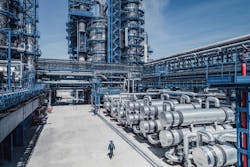Gazprom Neft’s Omsk refinery producing internationally compliant jet fuel
PJSC Gazprom Neft subsidiary JSC Gazpromneft-ONPZ has started production of jet fuel for the international aviation market as part of the second phase of the operator’s ongoing modernization program to reduce environmental impacts and improve processing capacities, conversion rates, energy efficiency, and production qualities at its 22-million tonnes/year Omsk refinery in Western Siberia (OGJ Online, Feb. 8, 2017).
In April, the Omsk refinery—which previously produced TS-1 aviation kerosine for the Russian market—began producing JET A-1 aviation fuel for jet and turboprop engines, with the first batch of deliveries of the internationally compliant fuel already completed to airports across the Asia-Pacific region, the operator said.
With ONPZ now equipped to produce up to 300,000 tpy of the new aviation fuel, Gazpromneft-Aero—Gazprom Neft’s subsidiary responsible distribution of JET A-1 fuel—now plans to expand deliveries to European airports as well, according to Mikhail Antonov, head of Gazprom Neft’s oil and gas refining directorate.
“Based on [International Air Transport Association (IATA)] data, we see potential for the recovery of the global aviation fuel market in the midterm…[and] expanding the range of high-quality aviation fuel will allow [Gazprom Neft] to enter new markets and refuel airlines beyond the Russian market with our own product…to increase the total volume of sales and attract new carriers to work with us,” said Vladimir Egorov, Gazpromneft-Aero’s chief executive officer.
ONPZ’s startup of JET A-1 fuel production results from Gazprom Net’s ongoing 700-billion rubles modernization program at the Omsk refinery subsidiary JSC Gazpromneft-MNPZ’s 12.2-million tpy Moscow refinery that—now in its second phase and due to be fully completed by 2025—has increased the manufacturing sites’ output of light oil products as well as expanded the resource base necessary for production of new in-demand products (OGJ Online, July 24, 2020).
Major project update
In a Feb. 18, 2021 conference call with investors to report full-year 2020 earnings, Alexey Yankevich, Gazprom Neft’s chief financial officer, said the company will execute a great deal of work to complete the more-extensive Omsk refinery modernization by 2022.
A major project under the more than 300-billion rubles Omsk modernization program now nearing startup includes ONPZ’s 2-million tpy advanced oil refining complex (AORC) that, once online, will use a combination of hydrocracking and sulfur-removal technologies to remove 99.8% of sulfur compounds from unfinished feedstock for production of Euro 5-quality fuel (OGJ Online, Feb. 19, 2020; July 12, 2017).
While it faced slight setbacks as part of Gazprom Neft’s optimization of its 2020 capital investment program due to the coronavirus (COVID-19) pandemic, ONPZ said on Mar. 31, 2021 that Russia’s Federal Service for Environmental, Technological, and Nuclear Supervision (Rostekhnadzor) has confirmed the AORC in full compliance with regulatory requirements for energy efficiency as well as industrial and environmental safety.
With construction and installation work on the complex now completed, ONPZ said it is currently testing equipment as part of the AORC’s commissioning.
Specifically, the complex will enable the Omsk refinery to flexibly regulate production levels for automobile and aviation fuels, as well as raw materials for lubricants. The central hydrocracking portion of the AORC also will ensure further processing of heavy petroleum fractions into diesel fuel, jet fuel, and other high-quality products in compliance with Euro 5-quality standards, according to the operator.
A project under the Russian federal government’s master plan for its Clean Air and Ecology projects adopted under a decree from President Vladimir Putin in May 2018 and with a production capacity of 8.4 million tpy, the new AORC also will feature a suite of technologies designed to reduce emissions at the site, including ongoing monitoring of environmental impacts as well as a closed-loop equipment drainage system allowing recoverable oil products to be sent for recycling.
Following startup of the new complex, ONPZ also will decommission six existing but obsolete units at the refinery, further reducing the site’s overall environmental footprint (OGJ Online, Mar. 13, 2020).
Gazprom Neft's current investment in construction of the Omsk refinery’s AORC exceeds 60 billion rubles, ONPZ said.
About the Author
Robert Brelsford
Downstream Editor
Robert Brelsford joined Oil & Gas Journal in October 2013 as downstream technology editor after 8 years as a crude oil price and news reporter on spot crude transactions at the US Gulf Coast, West Coast, Canadian, and Latin American markets. He holds a BA (2000) in English from Rice University and an MS (2003) in education and social policy from Northwestern University.

